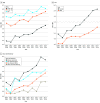Body Roundness Index and All-Cause Mortality Among US Adults
- PMID: 38837158
- PMCID: PMC11154161
- DOI: 10.1001/jamanetworkopen.2024.15051
Body Roundness Index and All-Cause Mortality Among US Adults
Erratum in
-
Error in Formula.JAMA Netw Open. 2024 Jul 1;7(7):e2426540. doi: 10.1001/jamanetworkopen.2024.26540. JAMA Netw Open. 2024. PMID: 38990575 Free PMC article. No abstract available.
Abstract
Importance: Obesity, especially visceral obesity, is an established risk factor associated with all-cause mortality. However, the inadequacy of conventional anthropometric measures in assessing fat distribution necessitates a more comprehensive indicator, body roundness index (BRI), to decipher its population-based characteristics and potential association with mortality risk.
Objective: To evaluate the temporal trends of BRI among US noninstitutionalized civilian residents and explore its association with all-cause mortality.
Design, setting, and participants: For this cohort study, information on a nationally representative cohort of 32 995 US adults (age ≥20 years) was extracted from the National Health and Nutrition Examination Survey (NHANES) from 1999 to 2018 and NHANES Linked Mortality File, with mortality ascertained through December 31, 2019. Data were analyzed between April 1 and September 30, 2023.
Exposures: Biennial weighted percentage changes in BRI were calculated. Restricted cubic spline curve was used to determine optimal cutoff points for BRI.
Main outcome and measures: The survival outcome was all-cause mortality. Mortality data were obtained from the Centers for Disease Control and Prevention website and linked to the NHANES database using the unique subject identifier. Weibull regression model was adopted to quantify the association between BRI and all-cause mortality.
Results: Among 32 995 US adults, the mean (SD) age was 46.74 (16.92) years, and 16 529 (50.10%) were women. Mean BRI increased gradually from 4.80 (95% CI, 4.62-4.97) to 5.62 (95% CI, 5.37-5.86) from 1999 through 2018, with a biennial change of 0.95% (95% CI, 0.80%-1.09%; P < .001), and this increasing trend was more obvious among women, elderly individuals, and individuals who identified as Mexican American. After a median (IQR) follow-up of 9.98 (5.33-14.33) years, 3452 deaths (10.46% of participants) from all causes occurred. There was a U-shaped association between BRI and all-cause mortality, with the risk increased by 25% (hazard ratio, 1.25; 95% CI, 1.05-1.47) for adults with BRI less than 3.4 and by 49% (hazard ratio, 1.49; 95% CI, 1.31-1.70) for those with BRI of 6.9 or greater compared with the middle quintile of BRI of 4.5 to 5.5 after full adjustment.
Conclusions and relevance: This national cohort study found an increasing trend of BRI during nearly 20-year period among US adults, and importantly, a U-shaped association between BRI and all-cause mortality. These findings provide evidence for proposing BRI as a noninvasive screening tool for mortality risk estimation, an innovative concept that could be incorporated into public health practice pending consistent validation in other independent cohorts.
Conflict of interest statement
Figures


Similar articles
-
Prognostic effect of body roundness index on all-cause mortality among US older adults.Sci Rep. 2025 May 22;15(1):17843. doi: 10.1038/s41598-025-02598-4. Sci Rep. 2025. PMID: 40404734 Free PMC article.
-
The association of body roundness index and body mass index with frailty and all-cause mortality: a study from the population aged 40 and above in the United States.Lipids Health Dis. 2025 Jan 30;24(1):30. doi: 10.1186/s12944-025-02450-8. Lipids Health Dis. 2025. PMID: 39885516 Free PMC article.
-
Association between body roundness index and stroke results from the 1999-2018 NHANES.J Stroke Cerebrovasc Dis. 2025 Mar;34(3):108243. doi: 10.1016/j.jstrokecerebrovasdis.2025.108243. Epub 2025 Jan 17. J Stroke Cerebrovasc Dis. 2025. PMID: 39826243
-
Associations of body roundness index with cardiovascular disease and mortality among patients with metabolic syndrome.Diabetes Obes Metab. 2025 Jun;27(6):3285-3298. doi: 10.1111/dom.16346. Epub 2025 Mar 27. Diabetes Obes Metab. 2025. PMID: 40145489
-
High Body Roundness Index Is Associated With Unhealthy Sleep Patterns: Insights From NHANES (2007-2014).Brain Behav. 2025 Jan;15(1):e70224. doi: 10.1002/brb3.70224. Brain Behav. 2025. PMID: 39740783 Free PMC article.
Cited by
-
A prospective study of comparing waist circumference and BMI as predictors for the kidney damage progression.PLoS One. 2025 Apr 29;20(4):e0321012. doi: 10.1371/journal.pone.0321012. eCollection 2025. PLoS One. 2025. PMID: 40299995 Free PMC article.
-
The Uric Acid to Albumin Ratio Predicts All-cause and Cardiovascular Mortality Among U.S. Adults Results from the National Health and Nutrition Examination Survey in 2003-2018.Int J Med Sci. 2025 Apr 22;22(10):2277-2288. doi: 10.7150/ijms.106664. eCollection 2025. Int J Med Sci. 2025. PMID: 40386059 Free PMC article.
-
Impact of body composition on fragility fractures in US elderly adults: a population-based study.BMC Geriatr. 2025 May 23;25(1):370. doi: 10.1186/s12877-025-05974-x. BMC Geriatr. 2025. PMID: 40410661 Free PMC article.
-
Exploring the role of the atherogenic index of plasma as a mediator between body roundness Index and cardiovascular events in older adults: a NHANES-based study.Front Cardiovasc Med. 2025 May 14;12:1506603. doi: 10.3389/fcvm.2025.1506603. eCollection 2025. Front Cardiovasc Med. 2025. PMID: 40438236 Free PMC article.
-
The nonlinear association between body roundness index and infertility in married women.Sci Rep. 2025 Jan 18;15(1):2431. doi: 10.1038/s41598-025-86948-2. Sci Rep. 2025. PMID: 39827325 Free PMC article.
References
-
- Neeland IJ, Ross R, Després JP, et al. ; International Atherosclerosis Society; International Chair on Cardiometabolic Risk Working Group on Visceral Obesity . Visceral and ectopic fat, atherosclerosis, and cardiometabolic disease: a position statement. Lancet Diabetes Endocrinol. 2019;7(9):715-725. doi:10.1016/S2213-8587(19)30084-1 - DOI - PubMed
Publication types
MeSH terms
LinkOut - more resources
Full Text Sources
Medical
Miscellaneous

